Now that you’ve got some experience building a Kingdomino, it’s time to learn some new tricks! The Queen is visiting—who can build the best Queendomino?
What Is Queendomino?
Queendomino is a tile-laying game for 2 to 4 players, ages 8 and up, and takes about 15 minutes to play; it can be combined with Kingdomino for up to 8 players, but does not require Kingdomino to play. It retails for $29.99 and is available now online or at your local game store. The game is pretty easy to learn even for kids, but engaging enough for adult players, too; it is a step up in complexity from Kingdomino.
Queendomino is GeekDad Approved!

Queendomino Components
- 4 starting tiles (square)
- 4 castles
- 8 king meeples (2 per color)
- 48 domino tiles
- 32 Building tiles
- 19 Knights
- 15 Towers
- Queen
- Dragon
- Building board
- 42 Coins (worth 1, 3, and 9)
- Score pad

All of the domino tiles are sturdy cardboard and are pre-punched. The thickness of the tiles and the sharp corners do make them a little tricky to shuffle well, but they look and feel pretty nice. As with Kingdomino, there are a lot of fun details in the illustrations on by Cyril Bouquet. This time, in tiles that have two different terrain types, there are often illustrations that cross over the center border. The new building tiles also have some really fun illustrations. The backs of the tiles look different from the Kingdomino tiles, so they’re easy to sort out if you play a game that combines the two.
The castles need to be punched out and assembled. Again, these aren’t totally necessary to the game, but they add a little bit of visual appeal to the game, and each castle has slightly different details on the illustrations. The king meeples are the same shape as in Kingdomino. The pieces in this game are orange, purple, red, and white—all four colors are different from the four colors in Kingdomino, which allows for mixing the two sets together without confusion over the player pieces. However, I’m not sure if the orange, red, and green (from the original) would cause any problems for red-green color blind players.
The coins are cardboard punch-outs, in different sizes and colors for the three denominations. I always point out that the large gold coin is worth 9 and not 6, because a lot of players assume it’s a 6.
The queen and dragon are wooden pawns with illustrations printed on them. The knights are very tiny black meeples—they can be a little tricky for larger hands to handle. The towers are grey rook-shaped meeples that are quite nice for building towers out of, if you’re so inclined.
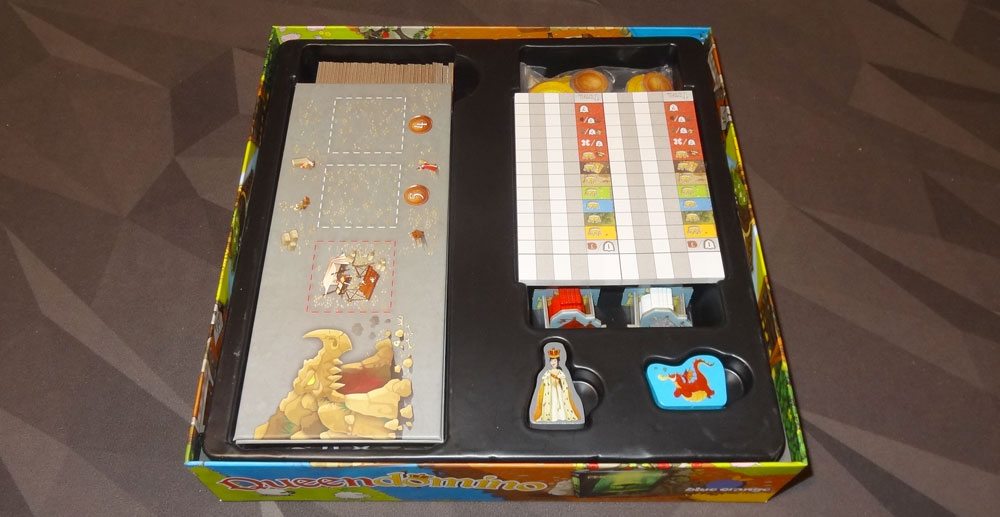
The box insert has room for the assembled castles, the meeples, the building tiles, and all of the domino tiles. As with the original game, it’s also handy as a way to hold all the dominoes during play, but since the box is bigger with the added components, it does take up a good deal of space. It may have been nice to have the domino tiles portion be a separate tray so that you could take it out for gameplay. Although the box is larger, it’s not designed to hold the components from Kingdomino, so you’ll just have to keep both boxes unless you ditch the plastic inserts.

The back of the rulebook has a handy chart showing how many squares of each terrain type there are, so you can gauge the probabilities of getting another windmill for your fields, or how many crowns there are in the mines, along with all the building types.
How to Play Queendomino
I’ll explain the basics of how to play, and then explain how to combine Queendomino with Kingdomino for more options. If you’re already familiar with Kingdomino and just want to know what’s new, skip down to the next section for an executive summary.
The Goal
The object of the game is to build your 5×5 kingdom to score the most points, creating valuable territories.

Setup
To set up, give everyone a starting tile, the matching castle, 7 coins, a knight, and meeples. (Players get 2 meeples in a 2-player game, or 1 meeple otherwise.) Shuffle the dominoes and then place them back in the box as a draw pile.
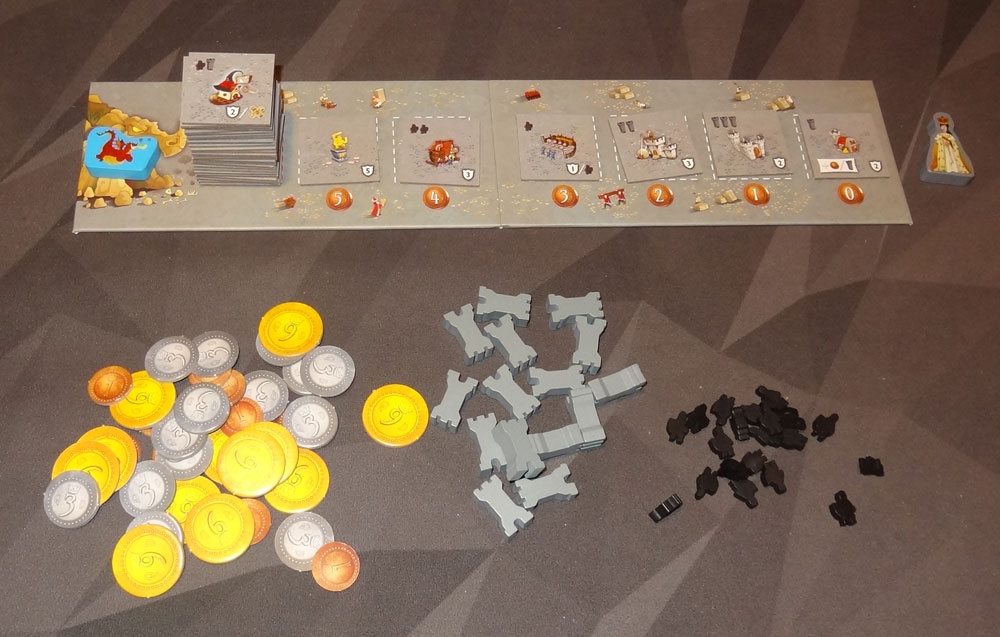
Set up the building board by shuffling the building tiles and then placing one on each of the spaces marked with a price, grey side up. Place the rest of the stack on the last space on the left. Place the dragon pawn in its cave on the building board. The rest of the coins, towers, knights, and the queen pawn are all placed nearby as a supply.

You start by laying out the first set of four dominoes: place them in numerical order, and then flip them over to reveal the terrain types. For the first round, randomize the turn order by shaking up the meeples and dropping them out one at a time. When your meeple drops, take it and place it on one of the dominoes that has not yet been claimed. Then, once all meeples have been placed, draw another set of dominoes, put them in order, and reveal them. (In a 3-player game, the tile that was not selected is discarded from the game.)
The game is ready to begin.
Gameplay
Each round, you start with the player whose meeple is on the lowest-numbered tile, and move down the row (so if you take the least valuable tile, then you’ll have first pick in the next round.) On your turn, you take the following actions in order:
- Add the tile to your territory.
- Send knights to collect tax. (optional)
- Construct a building. (optional)
- Bribe the dragon. (optional)
- Choose a new domino tile.
Add the tile: When you place a domino into your kingdom, it must be placed so that at least one end matches something that it’s touching. Your starting tile is wild, so anything can match it. Also, your entire kingdom must fit within a 5×5 grid (or a 7×7 grid for 2 players), so no tile may be placed so that any parts are outside that boundary. (Your castle does not have to be at the center of the grid.) If you ever take a tile but are unable to play it, it gets discarded and you’ll just have fewer tiles in your kingdom at the end of the game.

Collect tax: You may place knights from your supply onto one or both sides of the domino tile you have just placed. You then collect 1 coin for each square of the region where you placed the knight. The knight will stay there for the rest of the game.
Construct a building: If you have any open red town squares, you may construct one building from the building board. Each building’s price is indicated on the board—the rightmost building is free, and the leftmost building costs 5 coins. If there are towers and/or knights shown at the top left of the tile, claim those from the supply. Place the building on your town space, red side up; if you got any towers, they are placed on the tile. Knights go into your personal supply.
Whenever you have acquired the most towers (including when you tie with another player), the queen comes to your kingdom and is always placed in your largest territory. The queen counts as an extra crown for scoring, and also lowers all building costs by 1.

Bribe the dragon: If the dragon is still in its cave and the queen is not in your kingdom, you may bribe the dragon to burn down one of the available buildings. Pay one coin to the bank and then discard any of the available buildings on the building board—it is no longer available to build for the rest of the game. Place the dragon onto the empty space to indicate that the dragon has been used this round.
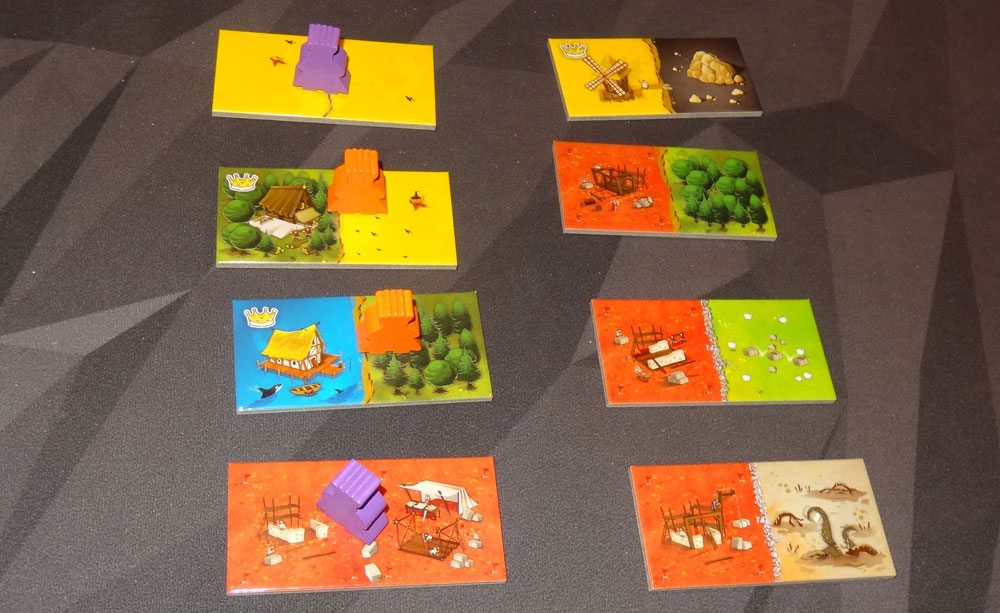
Choose a tile: At the end of your turn, you must choose a domino tile in the new line, placing your king meeple on it.
The turn now passes to the next player.
Once everyone has had their turn, put the dragon back in the cave, and slide all the buildings as far as they will go to the right, and then fill in any empty spaces with buildings from the stack. Form a new line of dominoes (again, putting them in numerical order before flipping them over). The new round starts.

Game End and Scoring
When you run out of domino tiles, it’s the last round of the game. Everyone will take a last turn, skipping the “choose a tile” step. Then everyone scores their kingdom.
You score 1 point for every 3 coins.
For the basic territories (not towns), you count up the number of squares in a contiguous region and multiply it by the number of crowns in that region. So a territory that has no crowns in it is worth no points. (Remember that the queen counts as an extra crown!)
Buildings score in different ways, and the scorepad helps you keep track of them. Some buildings simply have a score printed on them showing their value.
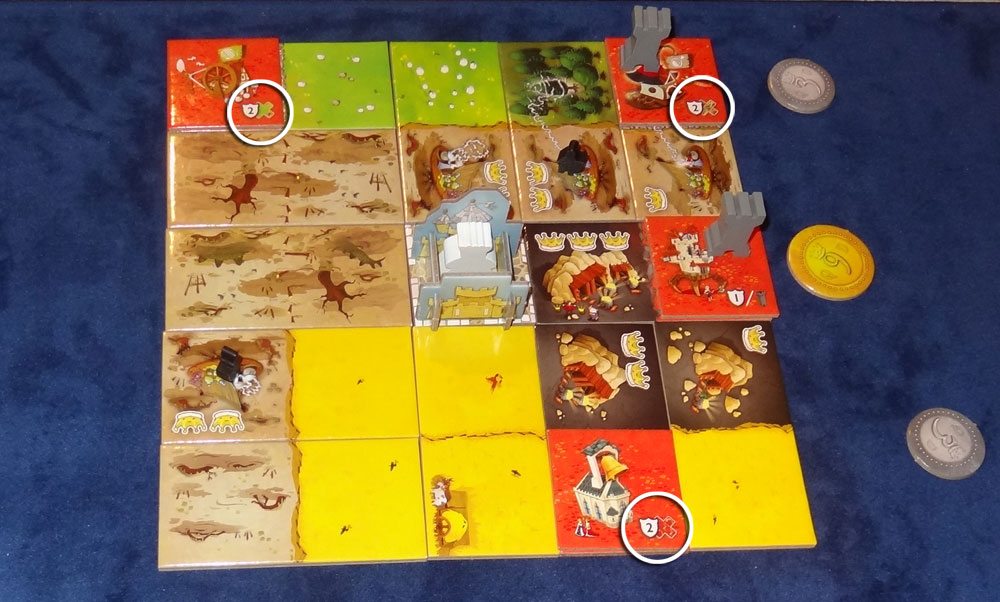
One type of building gives you points for separate territories of a particular type. In the photo above, the top left building gives 2 points per meadow territory, so it’s worth only 2 points. The building at the bottom gives 2 points per town territory, so it is worth 8 points because there are 4 separate town territories.
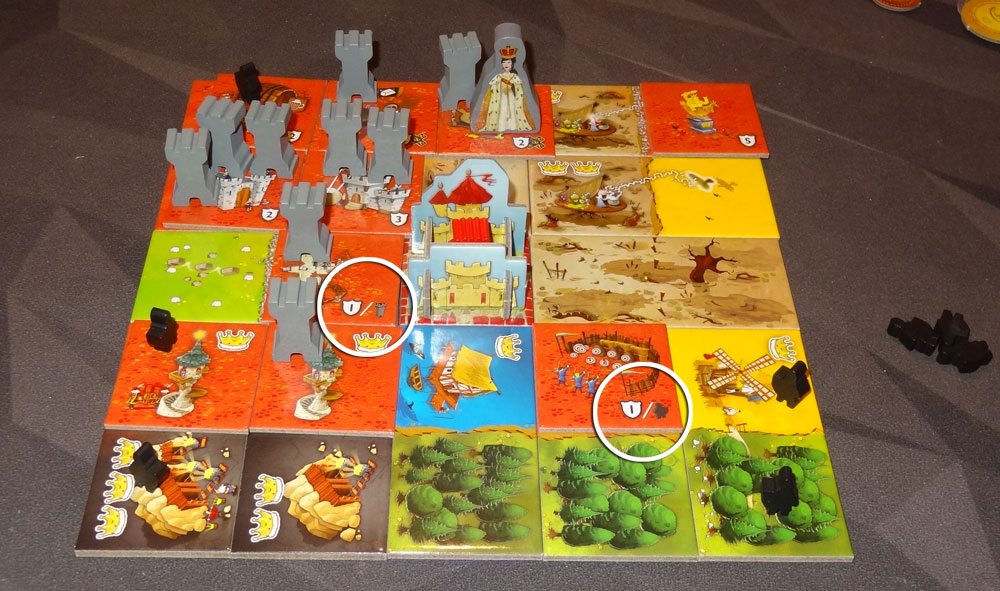
Finally, there are buildings that score points based on how many towers or knights you have. (This includes unused knights in your supply.)
Add up all of your points—the highest score wins, with ties going to the player with the largest single territory.
Variations
There are a few new variations if you include Kingdomino. When playing with both sets, you shuffle the domino tiles individually, and you alternate which set to pull tiles from each round, starting with Queendomino.
You can now build 7×7 grids with up to 4 players instead of just 2.
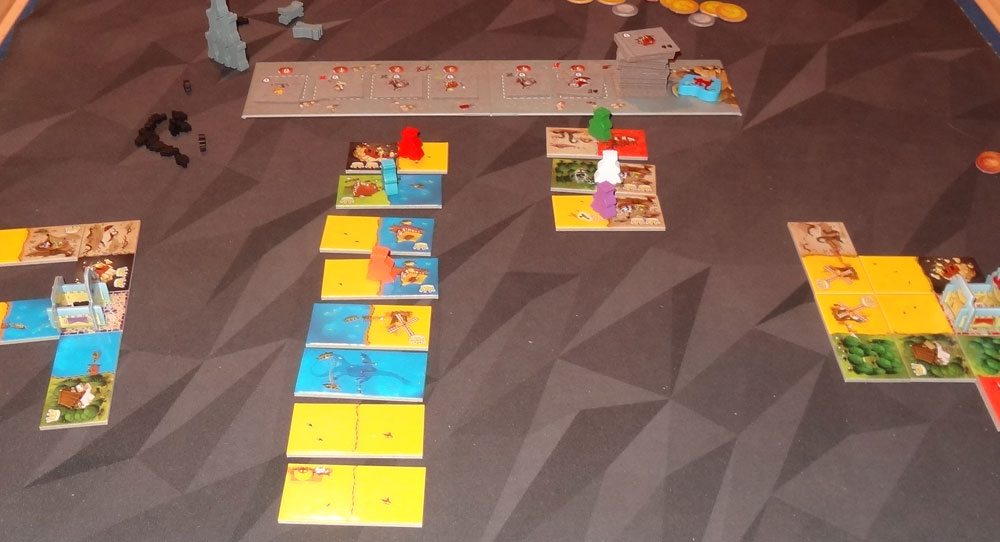
You can also play with up to 6 players with 5×5 grids. At the start of each round, lay out 8 dominoes, and discard any tiles that weren’t claimed. (Note: I’m not sure why you can’t play an 8-player game using this method, other than that it may get a little long.)
You can also play with 6 or 8 players in teams of two. Team members sit side by side; each player has their own color meeple, but they share starting resources—1 knight and 7 coins. Within each team, players can consult each other, but each player is free to decide on the placement of their domino tile and whether to use knights or coins on their turn. This will build 7×7 grids.
What’s New in Queendomino
Queendomino adds a number of new features. If you’re already familiar with Kingdomino, here’s a quick list of what’s been added.
Towns
The red regions are towns, which can be built on. They don’t have any crowns on them, so you won’t score automatically for having large town territories.

Buildings
Buildings are paid for with coins and placed onto your town areas. They can be worth points, or have crowns on them, or give you points for meeting certain requirements. Some buildings also give you towers or knights.
Towers
Some buildings come with towers on them. Whoever has the most towers will host the queen.
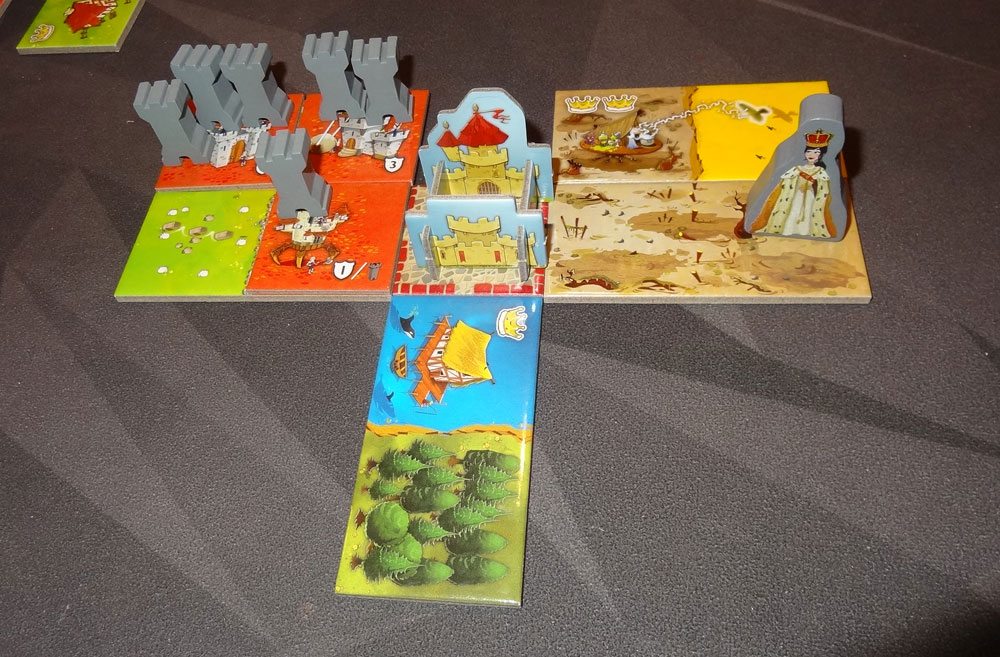
The Queen
The queen gives a 1-coin discount on buildings and counts as a crown at the end of the game. She goes to kingdom with the most, newest towers.
Knights
Knights are used to tax your kingdom to earn money—you can place knights on either or both sides of a tile when you place it in your kingdom. Each knight collects 1 coin per connected square of its territory.
Money
Money is used to buy buildings or bribe the dragon. Unspent money is worth points at the end of the game.
The Dragon
You can bribe the dragon 1 coin to burn down a building on the building board so that it can’t be purchased, but the dragon only burns once per round.
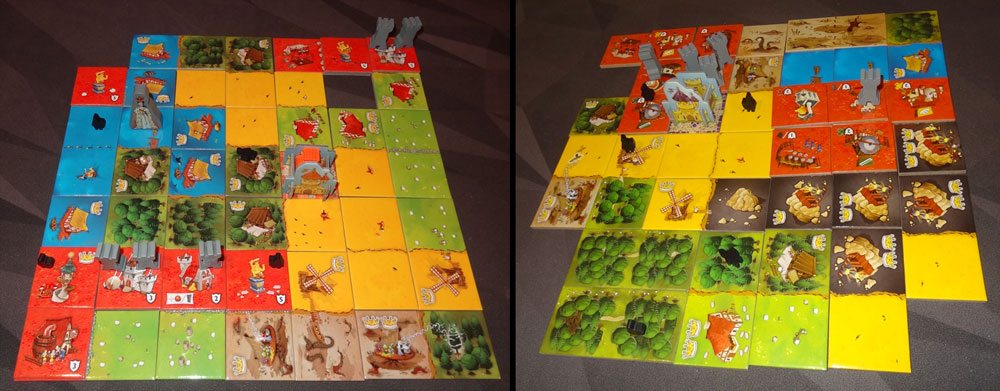
Rules Changes
Aside from the above additions, there were a couple of rules tweaks. For one, the 2-player game always uses a 7×7 grid now rather than that being a variant. Also, you always lay out four tiles, even in a 3-player game, and discard the unchosen tile. I found that was easier than counting out a particular number of tiles to use, and also meant that every tile would appear in every game.
Why You Should Play Queendomino
I gave Kingdomino the GeekDad Approved seal earlier this year—I’ve found it to be a really great game that I can introduce to a broad range of gamers, and it has generally gotten a very good reception from everyone I’ve played it with. So I’ve been looking forward to Queendomino to see how it changes the game and whether it’s as fun as the original. What I found is that Queendomino keeps the feel of Kingdomino but adds another layer of complexity and strategy to it. It feels like a meatier game, which is great if you liked the original but wanted more options, but also means that it may not appeal to quite as broad an audience.
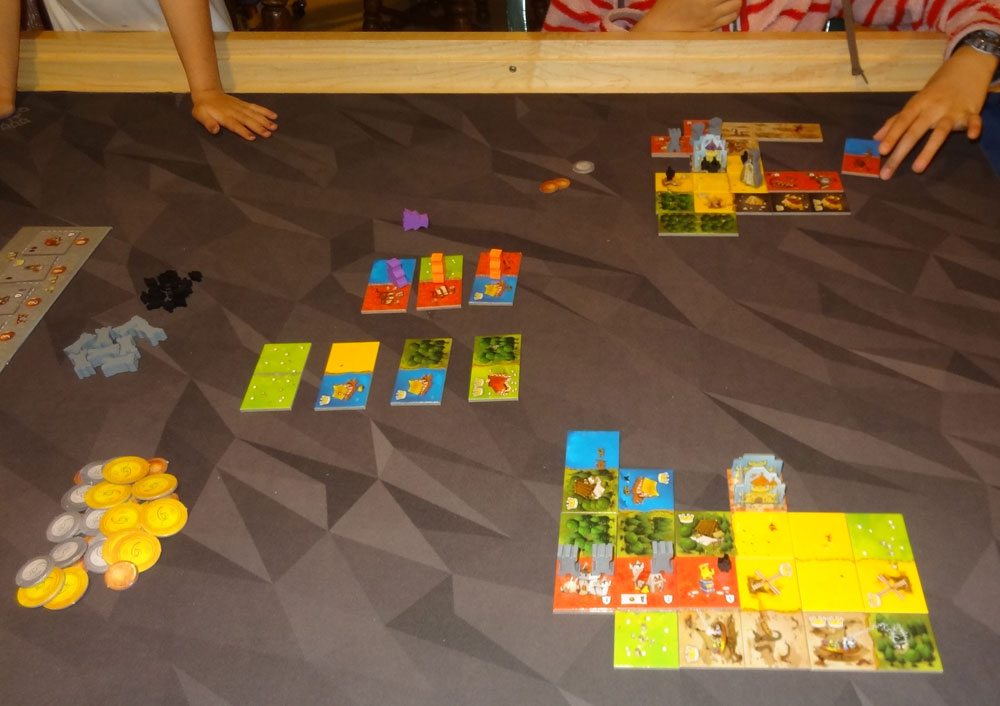
My 11-year-old daughter was a really big fan of Kingdomino, so we were both excited to add Queendomino to the mix. What I found is that although she really enjoys the new game, she has more trouble competing because it’s more complex. When you take a tile with a town area on it, you really have to consider whether you’re going to just build a few points on it, or build out the region and hope to get a couple crowns on it, or if you’re just trying to get some more knights so you can tax.
Before, taking a low-value tile was a gamble: you didn’t know which tiles would be coming next and whether getting first pick would be worth it. Now, there are other reasons for going first besides the tile choice: you may want to be first to build a building or bribe the dragon, knowing that an opponent has their eyes on a particular building. If you go first, you can essentially remove two buildings from the market in one turn.

The variety of buildings opens up a lot of new strategies. You can still score a lot of points in the original way—large territories with lots of crowns—and that’s often where the majority of points still come from. But the buildings can supplement your score. For instance, the new territory-specific buildings (seen above) give you points for disconnected territories. While that’s not as efficient as building a large area with crowns in it, it does mean that if you end up with a few disconnected pieces of field or meadow or swamp you can still get some value from them.
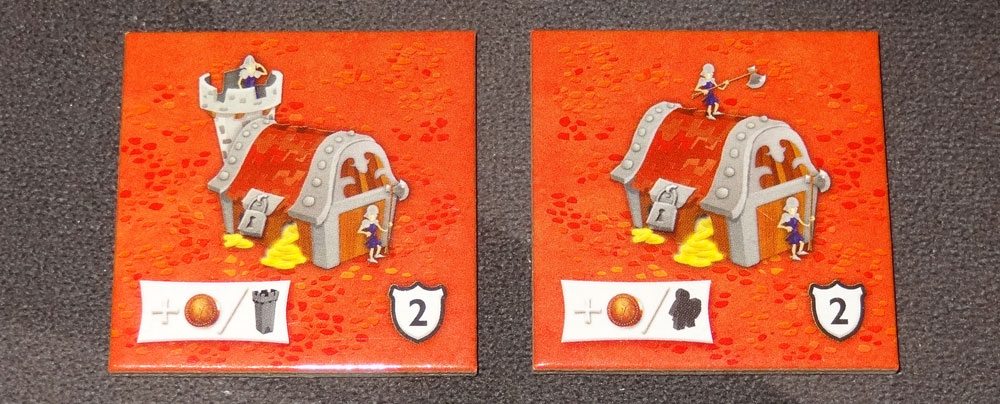
Some buildings don’t give you a lot of points in themselves, but may help you as you figure out your strategy. The buildings pictured above give you extra coins when you tax based on how many towers or knights you own. Combine these with buildings that give you more points for towers or knights, and you can get a nice snowballing effect.
And, of course, there are a few buildings that have crowns on them, turning your town spaces into another points-scoring region. Those are harder to come by, so I don’t normally bank on them, but it’s another way to add some value to those towns.
The tricky part is that the buildings can sometimes be a red herring if you don’t know what you’re doing. Buying the territory-specific buildings is almost worthless if you manage to connect all your territories; getting a crown building isn’t great if you don’t have a lot of town spaces. Figuring out the balance between the normal territories and the town territories takes some experience and some luck, so I think Queendomino is best for those who are already experienced with Kingdomino even though it’s not strictly a prerequisite.

I really do like the option to combine the sets, allowing for more players at once or having a 4-player 7×7 competition. I think for me, given the option, I’d usually take Queendomino myself. However, depending on the experience level of those I’m playing with, I think Kingdomino is a much easier entry. The combined games do tend to take significantly longer than a game of standard Kingdomino, which is another reason Kingdomino makes for a better introduction. If your gaming group is satisfied with the depth of Kingdomino, you might not need to complicate things just yet.
There is enough of a change in the gameplay that I think it’s worth having both titles in your game library, particularly if Kingdomino feels a little light for your gaming group. Queendomino makes the game a bit more of a challenge, and that might be just what your group is looking for.
Click here to see all our tabletop game reviews.
If you’d like to stay up-to-date with all of our tabletop gaming coverage, please copy this link and add it to your RSS reader.
Disclosure: GeekDad received a copy of this game for review purposes.
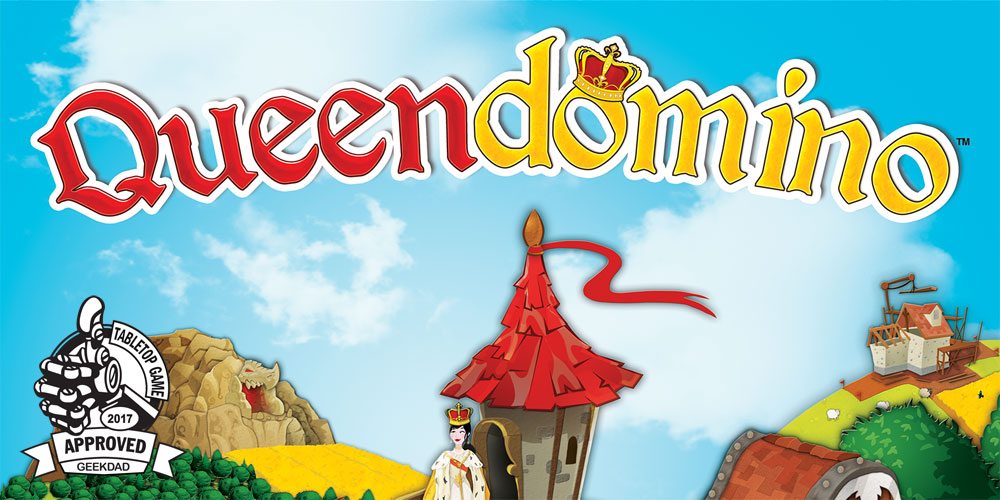
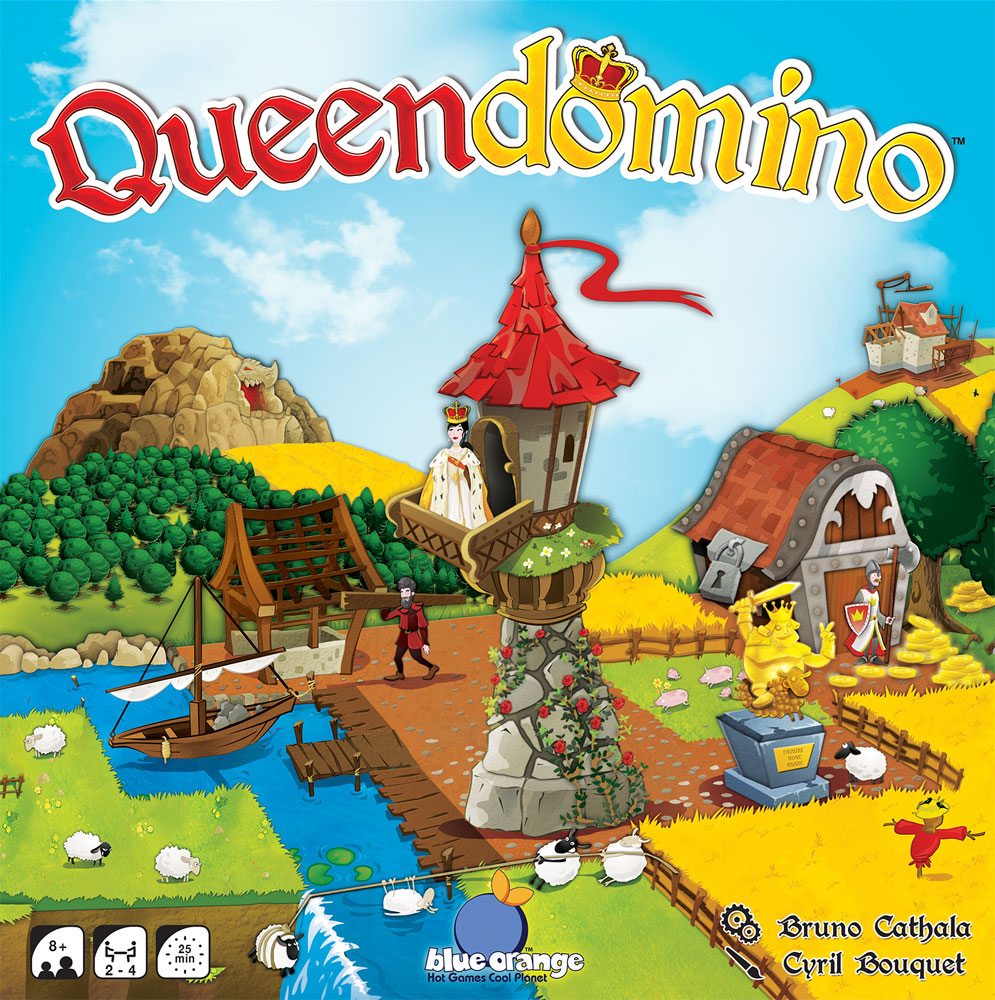




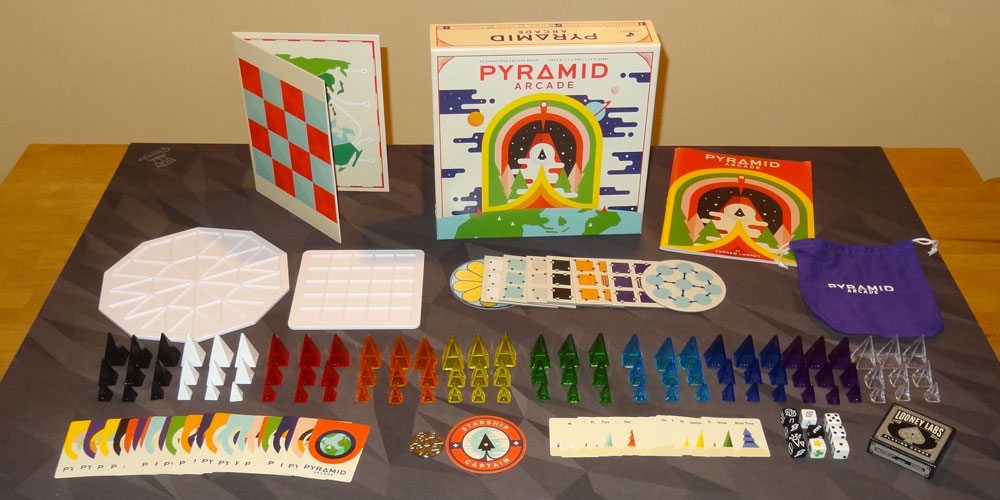
I just bought it! already a lot of fun with my friends and my girlfriend. You’re right, it is a bit more challenging !Thanks for the review